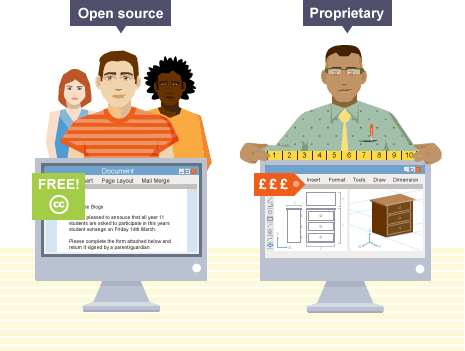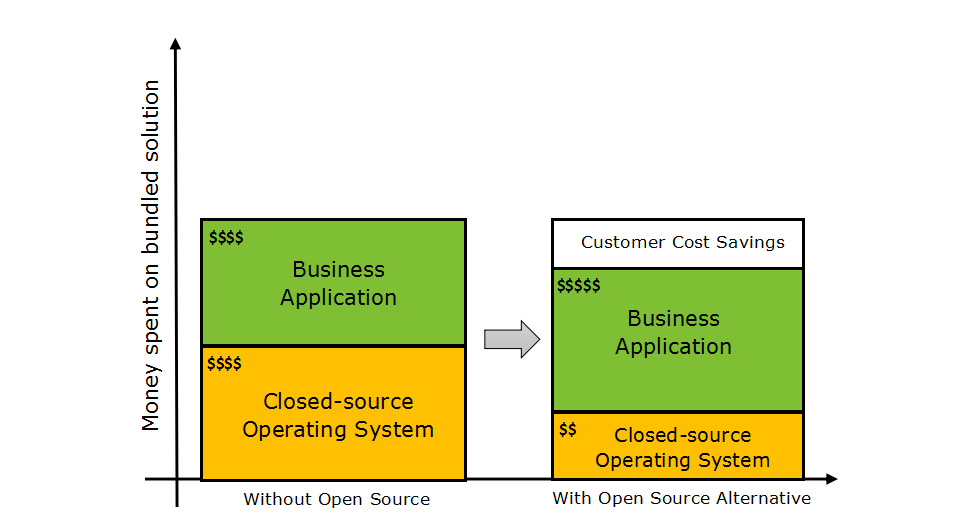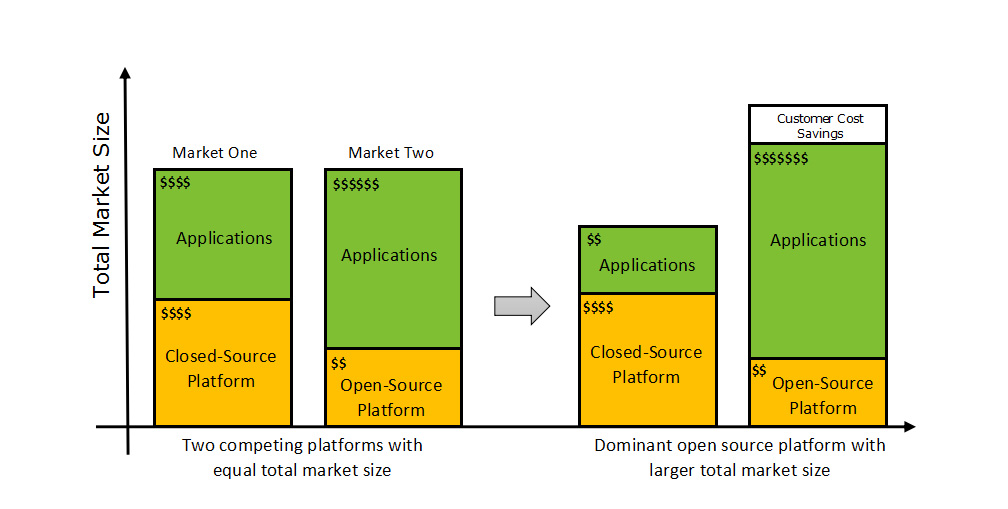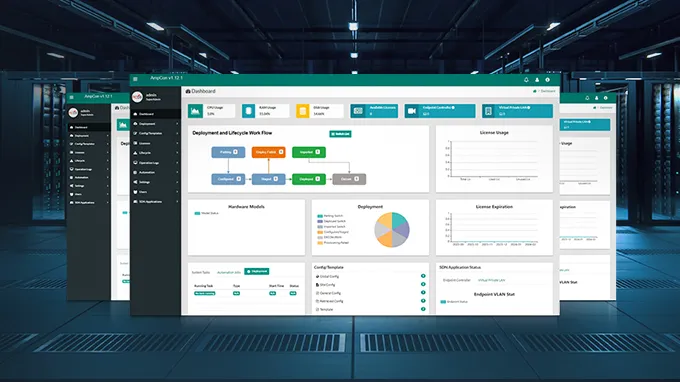Network OS Comparison: Open Source OS or Proprietary OS
For a long time, network engineers have had no choice but to work with monolithic switches designed with vertically integrated hardware and software. While with pioneer bare-metal switch vendors gaining momentum, the network switches are changing. Software and hardware vendors are innovating.
Generally, network switch vendors categorize the network operating system software into two types which are monolithic operating system and modular operating system. Traditional monolithic operating system designs use one static-compiled image and run in a single memory address space. This means that network switches are always running in an "all or nothing" mode. If any one element or application within an operating system fails or needs to be updated, the entire system must be shut down and restarted, ceasing all packet flows. However, the main elements of a network switch modular operating system include a kernel and a set of dynamically loadable applications. These applications have their own separate and protected memory spaces. The kernel is protected from service and application failures. Each process can be monitored to determine if it is operating correctly. If there is a problem, the process can be restarted dynamically, thus avoiding a reboot of the entire system.
Switch OS Blossoms: Open Source OS vs. Proprietary OS
Currently, there are proprietary operating system and open source operating system. Generally, the proprietary OS or closed source OS is conceptualized, designed, developed and sold by a particular company and not meant to be tampered with or tweaked by users. Proprietary OS typically runs on name-brand vertically integrated switches. While the open source OS can be used, changed, and shared by anyone. It is made by many people, and distributed under licenses that comply with the Open Source Definition. Open source network operating systems normally run on open switches, white-box switches, or bare-metal switches.

Figure 1: Network OS comparison: open source OS or proprietary OS
Please Note: there are two types of open source software—project/community open source and commercial open source software (COSS). Community open source is completely free to anyone to download, including source code, for evaluation. Even COSS vendors usually have a free version of their software package, which includes source code. In fact, much open source software, especially OSs, are available as “live” media meaning that you need not actually install the software but instead run it directly from a DVD or USB flash drive.
Table 1: Part of open source OS and proprietary OS (closed source OS) in the market.
| Open Source OS | Proprietary OS (Closed Source OS) |
|---|---|
| Cumulus Linux distribution using the full TCP/IP stack of Linux Open Network Operating System (ONOS) PicOS®, Linux-based OpenFlow-supporting OS from Pica8 VyOS, an open source fork of the Vyatta routing package OpenSwitch Linux Network OS from Hewlett-Packard Switch Light OS from Big Switch Networks ZebOS from IP Infusion Broadcom ICOS | JUNOS, used in routers and switches from Juniper Networks Cisco Internetwork Operating System (IOS) IPOS, used in routers from Ericsson FortiOS, used in Fortigates from Fortinet TiMOS, used in routers from Alcatel-Lucent EXOS, used in network devices made by Extreme Networks ZyNOS, used in network devices made by ZyXEL |
The network OS comparison between open source OS and proprietary OS centers on the fact that open source software publishes the source code. In contrast, proprietary software retains the source code. Both the two have their own pros and cons.
Cost—One of the main advantages of open source software. If you have the in-house capabilities and technical expertise to maintain the software, and resources to implement, train and provide support to staff, then open source may be most cost-effective for your organization. For a closed source CMS, the cost depends on the system's complexity. The range can vary from a few thousand to a few hundred thousand dollars. This includes a base fee for software, integration, and services. It also encompasses annual licensing and support fees.

Figure 2: Open source OS and proprietary OS cost comparison
As the picture shows, for the customer, an open source alternative saves money, while for the business application vendor more money becomes available, at the expense of the closed source operating system vendor, who misses a sale.
Usability—Usability is often a major area of criticism for open source, because technology is generally not reviewed by usability experts and caters to developers rather than the vast majority of layperson users. For closed or proprietary software, usability is a high selling point due to expert usability testing for a more targeted audience.
Security—Security of open source is often a concern for large companies because software is not always developed in a controlled environment. One way to reduce this potential risk is to adopt a reputable brand with a concentrated development team supported by a strong online community. And it requires more technical knowledge and effort to install, configure and maintain open source software. Proprietary or closed software is generally seen as more secure because it is developed in a controlled environment by a concentrated team with a common direction.

Figure 3: Network OS comparison: open source OS and proprietary OS with different features
How Network OS Affects the Network Switch Hardware Market
Not all switches are created equal. At present, the switches in the market can be divided into two categories. One involves bare-metal switches, decoupling hardware from software. It allows third-party software to be used on the switch. The alternative is a traditional vendor-based switch offering that comes with pre-loaded proprietary software. For any network engineer, reliability and support are nonnegotiable requirements. Some contend that open switches can provide greater reliability than proprietary ones.
Firstly, proprietary switches are more expensive. For the price of one traditional switch from Cisco, an enterprise can purchase at least four open switches and affordably keep multiple spares or redundant pairs on hand.
Secondly, when a proprietary switch fails, waiting for replacement parts can be costly due to potential downtime. In contrast, bare-metal switches offer easier and more cost-effective reliability, with support often manageable in-house. Many third-party operating systems on bare-metal switches are Linux-based, allowing administrators to troubleshoot and manage them using server tools they already have. This minimizes reliance on vendors, reducing the time spent waiting for help desk ticket processing or replacement parts shipment.
Thirdly, for many enterprises, the team running the data center comes from the IT side, so there is no reason why a switch should be provisioned differently than a server. They want to manage them like servers and want them to be programmable. Bare-metal switches offer that option and allow them to select a specialized network operating system according to their needs.
Therefore, bare-metal switches are considered by many network guys. When choosing bare-metal switches, besides the software performance, you should also pay attention to some hardware parameters, such as switching capability, throughput, latency, non-blocking bandwidth, etc. For instance, FS.com N-series 25G/100G open switches are high performance L2/L3 switches. They have high switch capability, low latency and large throughput, which are perfect for next generation metro, data center and enterprise network applications. Furthermore, both the bare-metal type and those with pre-loaded licensed Broadcom ICOS and Cumulus Linux OS can be offered. With our bare-metal switch, you can install the network operating system according to your special requirements, such as OcNOS , Open Network Linux, PicOS®, etc.
Open Source OS Still in Continuing Development
In the recent past, open source OSs have seen a significant developments. It’s going strong after nearly 30 years and still has its die-hard supporters. The quality of service (QoS) of the open source software outperforms the proprietary software in many areas. There is no doubt that the business model for open source licensing and products is establishing itself in the mainstream, especially as open source gains momentum with a growing community, contributors. Even so, open-source operating systems still have a long way to go. They have only established a considerable presence in the software world, but they have not completely won over proprietary operating systems, or have not completely displaced proprietary and closed-source alternatives in the comparison of network operating systems.

Figure 4: Growing an open source platform increases the total market size
Figure 4 illustrates the dynamics of shrinking a closed source platform to the advantage of an open source platform. The money leaving the market around the closed source platform enters the market for products built on top of the open source platform. As customers review the choice of products available, they prioritize purchases anew in accordance with what’s available and how big their IT budget is. This dynamic is particularly attractive to the providers of mission-critical applications, which typically get higher purchasing priority than less important, more incremental applications.
You might be interested in
Email Address

-
PoE vs PoE+ vs PoE++ Switch: How to Choose?
May 30, 2024













